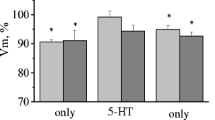Abstract
An increase was found at the level of the command neurons of defensive behavior in the amplitude of summary excitatory postsynaptic potential (EPSP) recorded in the command neurons in response to nerve stimulation; as were an increase in the probability of the occurrence of an action potential in the reaction, and under certain conditions, a substantial decrease in the rate of habituation during rhythmic (0.1 Hz) nerve stimulation in the presence of a peptide. This last effect was observed when two groups of neurons, the control and those to which the peptide was presented prior to the first stimulation series in the experiment, i. e., without the preceding development of habituation, were compared. The decrease in the rate of habituation affected both the amplitude of the summary EPSP and the probability of the occurrence of an action potential in the reaction. All these changes in the presence of the analog may underlie the increase in spike reactions of the command neurons of defensive behavior, and may thus underlie the initiation or an increase in defensive behavioral reactions. The effects obtained were not long-lived, and took place only in the presence of the peptide in the extracellular milieu.
Similar content being viewed by others
Literature cited
P. M. Balaban and E. G. Litvinov, “Command neurons in the arc of the unconditioned reflex in the edible snail,”Zhurn. Vyssh. Nervn. Deyat.,27, No. 3, 538–544 (1977).
G. G. Gasanov, G. Telegdi, and R. Sh. Ibragimov, “The influence of neurophysiological peptides on the formation of a conditioned alimentary reflex in rats,”Zhurn. Vyssh. Nervn. Deyat.,36, No. 5, 905–912 (1986).
R. I. Kruglikov, “The neurochemical mechanisms of memory,” in:The Mechanisms of Memory, I. P. Ashmari, Yu. S. Borodkin, P. V. Bundzen, et al. (eds.) [in Russian], Nauka, Leningrad (1987), pp. 78–87.
I. V. Kudryashova, “Habituation in command neurons in the presence of an analog of vasopressin in the edible snail,”Zhurn. Vyssh. Nervn. Deyat.,37, No. 4, 782–784 (1987).
I. V. Kudryashova, “The influence of an analog of vasopressin on spontaneous synaptic activity,”Zhurn. Vyssh. Nervn. Deyat.,37, No. 3, 578–580 (1987).
I. V. Kudryashova and D. B. Logunov, “The dynamics of change in the excitability of neurons of an analog of vasopressin in the edible snail,”Zhurn. Vyssh. Nervn. Deyat.,36, No. 6, 1116–1124 (1986).
I. V. Kudryashova and N. V. Orlova, “The participation of various brain structures in the effects of vasopressin on the processes of learning and memory,” in:Prospects for the Clinical Application of Peptide Preparations [in Russian], Moscow (1987), pp. 57–61.
E. G. Litvinov, “The pacemaker potential in the organization of the unconditioned reflex arc,” in:The Pacemaker Potential of the Neuron [in Russian], Metsniereba, Tbilisi (1975), pp. 130–176.
O. S. Papsuevich, G. I. Chipens, and S. V. Mikhailova,Neurohypophyseal Hormones [in Russian], Zinatne, Riga (1986).
S. K. Sudakov, “A possible role of oxytocin and vasopressin in the dominance of defensive motivation in rabbits,”Zhurn. Vyssh. Nervn. Deyat.,37, No. 1, 160–162 (1987).
A. F. Crine and R. M. Buijs, “Electric footshocks differentially affect plasma and spinal cord vasopressin and oxytocin levels,”Peptides,8, No. 2, 243–246 (1987).
D. De Wied, “Pituitary neuropeptides and behavior,” in:Central Regulation of the Endocrine System, Plenum Press, New York, London (1979), pp. 297–314.
D. De Wied and B. Bohus, “The modulation of memory processes by vasotocin, the evolutionarily oldest neurosecretory principle,”Progr. Brain Res.,48, No. 2, 327–334 (1978).
J. Dögterom and R. M. Buijs,”Vasopressin and oxytocin. Distribution in rat brain: immunoassay and immunocytochemical studies,” in:Neuropeptides and Neural Transmission, Vol. 7, C. A. Marsan and W. Z. Traczyk (eds.), Raven Press, New York (1980), pp. 307–314.
A. Ermish, R. Landgraf, and P. Mobius, “Vasopressin and oxytocin in brain in brain areas of rats with high or low behavioral performance,”Brain Res.,379, No. 1, 24–29 (1986).
O. J. W. Gaffori, C. Nyakas, H. D. Veldhuis, et al., “Behavioral profile of vasopressin deficient rats (Brattleboro strain) as assessed in open field and in appetitively and aversively motivated behavioral test stimulation,”Behav. Brain Res.,20, No. 8, 98 (1986).
G. L. Kovacs, G. Szabo, Z. Saznyai, and G. Telegdy,”Neurohypophyseal hormones and behavior,” in:Neuropeptides and Brain Function, E. R. Kloet, V. M. Wiegant, and D. De Wied (eds)., Elsevier, Amsterdam (1987), pp. 109–118.
P. Lacszi, O. Gaffori, E. R. Kloet, and D. De Wied, “Differential regulation in immunoreactive arginine vasopressin content of microdissected brain region during passive avoidance behavior,”Brain Res.,260, No. 2, 342–346 (1983).
C. Lebrun, M. Le Moal, R. Dantzer, et al., “Hypertonic saline mimics the effects of vasopressin of inhibitory avoidance in the rat,”Behav. and Neurol. Biol.,47, No. 2, 130–137 (1987).
K. Lukowiak and W. F. Colmers, “Endogenous peptides work at multiple sites in the nervous system in the control of gill behavior in Aplysia,”Regul. Pept.,17, 99–109 (1987).
H. R. Olpe and V. Baltzer, “Vasopressin activates noradrenergic neurones in the rat Locus coeruleus: a microiontophoretic investigation,”European J. Pharmacol.,73, 377–378 (1981).
T. Onaka, M. Hamamura, and K. Yagi, “Suppression of vasopressin secretion by classically conditioned stimuli rats,”Japan J. Physiol,36, No. 6, 1261–1266 (1986).
L. P. Renaud and A. Padjen, “Electrophysiological analysis of peptide actions in neural tissue,” in:Centrally Acting Peptides, MacMillan Co., New York (1978), pp. 59–84.
S. J. Sara, J. Barnett, and P. Toussant, “Vasopressin accelerates appetitive discrimination learning and impairs its reversal,”Behav. Proc., No. 7, 159 (1982).
T. B. G. Van Wimersma, J. M. Van Ree, and D. H. G. Versteeg, “Neurohypophyseal peptides and avoidance behavior: the involvement of vasopressin and oxytocin in memory processes,” in:Neuropeptides and Neural Transmission, C. A. Marsan and W. Z. Traczyk (eds.), Raven Press, New York (1980), pp. 293–300.
Author information
Authors and Affiliations
Additional information
Translated from Zhurnal Vysshei Nervnoi Deyatel'nosti imeni I. P. Pavlova, Vol. 40, No. 4, pp. 754–761, July–August, 1990.
Rights and permissions
About this article
Cite this article
Kudryashova, I.V., Kruglikov, R.I. Influence of an analog of vasopressin on the reaction of command neurons of defensive behavior of the edible snail during the stimulation of nerves. Neurosci Behav Physiol 21, 513–519 (1991). https://doi.org/10.1007/BF01185941
Received:
Revised:
Issue Date:
DOI: https://doi.org/10.1007/BF01185941



